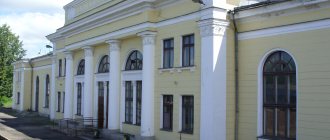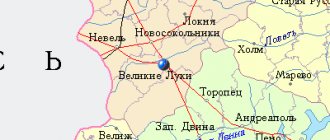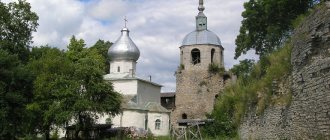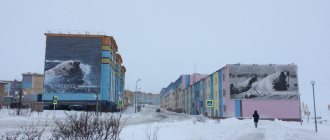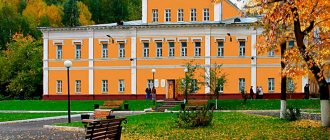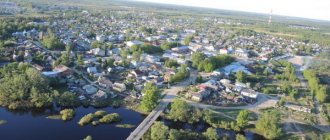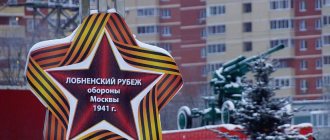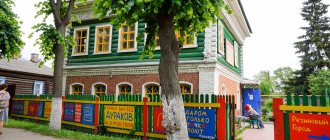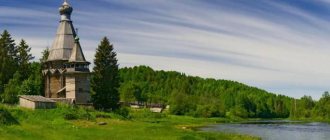Sebezh: areas, recreation, excursions, museums and churches, cuisine and restaurants, shopping and shops, attractions of Sebezh.
- New Year tours
to Russia - Last minute tours
to Russia
Sebezh, located just 180 km from Pskov, is famous for its interesting history and a considerable number of attractions. First of all, this is the so-called Castle, located in the old part of the city. Previously, these were wooden fortifications of Ivangorod-on-Sebezh (16th century). Today you can get there by walking from the city center up Proletarskaya Street to the Cape.
How to call
+7-81140-phone number
Hotels
There are 2 hotels in Sebezh:
- “Sebezh”, located in the very center, has single, double and quadruple rooms, as well as a cafe where you can eat (opening hours: from 8:00 to 2:00). Address: st. Proletarskaya, 54a; tel.: 3-55-65.
- “Pribaltiyskaya”, which is located somewhat on the outskirts, where there is also a bar (opening hours: 8:00-22:00). Address: st. Margot, 58; tel.: 3-54-03, 3-54-50.
In addition, on the territory of the Sebezhsky national park there is a tourist complex of houses on the shore of the lake - the Ozeravki base, where you can stay. For rental questions, please contact the administration of the national park: Sebezh, st. November 7, 22. Phone numbers of the park administration: 8 (81140) 214-22, 212-38 - department of environmental education and tourism from 9:00 to 13:00 and from 14:00 to 17:00.
Sebezh architectural monuments
More than 20 Sebezh buildings have been recognized as architectural monuments of regional significance. Most of the century-old houses are located in the historical center of the city - on Proletarskaya Street.
House of the merchant Bruskin
- Address: Proletarskaya, 31.
The two-story stone mansion on Proletarskaya Street is one of the most famous buildings in the city. An unremarkable house in the neoclassical style in the 19th century belonged to the merchant of the 2nd guild Moses Bruskin.
Moisei Izrailevich traded timber, and his wife took care of a large family. During Soviet times, the city council was located in the mansion. The architectural monument has been preserved in good condition; today the premises are occupied by a notary's office and other organizations.
House of merchant Selyugin
- Address: Sovetskaya street, 13.
The brick mansion of the Sebezh merchant Selyugin was built in 1890, as evidenced by the mortgage board on the facade of the building. Above the name of the owner and the date of construction, a short prayer is inscribed in capital letters: “Lord, protect this house from all evils and do not forsake those who trust in Thee.”
The businessman's former possessions are one of the richest in the city: in addition to a two-story house, they include a warehouse, a trading store and a number of outbuildings.
Today, several families live in the renovated merchant house; modern plastic windows adorn the window openings of the architectural monument. One of the warehouses of the architectural complex is used as a store.
House of the priest
- Address: Zamkovaya, 12.
Not far from the former Church of the Holy Trinity there is a house in which Catholic clergy once lived. According to local historians, the construction of a small one-story building was completed in 1890. After the church was closed, the priest's house was nationalized.
Since 1948, it housed the district military registration and enlistment office. Nowadays, the department of the Federal Tax Service of the Russian Federation for drug control operates in the building, but the authorities plan to transfer the architectural monument to the Trinity Church as a clergy house.
Medunetsky's House
- Address: Zamkovaya, 6.
The rich and prolific Medunetsky family owned several buildings on Proletarskaya and neighboring streets. One of the largest mansions of the landowner (Proletarskaya, no. 18) was erected in the first half of the 19th century.
In the first years of Soviet power, the house became the property of the working people, after the war it was adapted into a House of Culture. The second floor of the building was occupied by the library and the National Park office. Then the old house was transferred into private hands. When the mansion fell into disrepair, it was simply abandoned.
Over the past years, the architectural monument has not been restored. The dilapidated building makes a depressing impression; it is better to observe it from a distance, since the roof and walls periodically crumble and threaten to fall on passers-by.
Apartment house Rutkovsky
- Address: st. Proletarskaya, 25.
Before the Revolution, wealthy Sebeans built mansions not only for their families, but also for rent. Some similar buildings have survived to this day, one of them is the Rutkovsky apartment building, built in the second half of the 19th century.
Just like many other rich townspeople, the landowner built his house on the most crowded street of Peter the Great.
The two-story corner brick building fits perfectly into the architectural appearance of the historical city center. In 1998, the mansion was given the status of a monument of urban planning and architecture. Currently, the building houses the Central District Library.
Entertainment and attractions of Sebezh
Proletarskaya Street from the central square of the city rises steeply uphill, passes the bell tower, the Church of the Holy Trinity and comes out on a steep 16-meter-high cape. Here stood Ivangorod-on-Sebezh, from which the fortifications of the 16th century have been preserved; this is the place called the Castle.
The most striking building in the city is the white stone bell tower, preserved from the Church of the Holy Trinity, built in the 17th century (formerly a Polish Catholic church). Also interesting is “Petrovskaya Gora”, located in the center of the city - one of the fortified points built by order of Peter I during the Northern War (1700-1721).
It is worth a walk to the healing mineral spring (Holy Spring, as the locals call it), which is located on the outskirts of the city, on the road to Glembochino.
Not far from Sebezh, where the borders of Russia, Belarus and Latvia meet, the Mound of Friendship is located - a monument to the courage and heroism of Russian, Belarusian and Lithuanian partisans who fought together against the Nazis. Every year on the first Sunday in July, former partisans, underground fighters, children and grandchildren of those who defended the independence of the Motherland, as well as numerous tourists come here. And at the end of July - beginning of August, a three-day Festival of youth coming from border states is held on the territory of the Mound of Friendship.
Every summer, on the first weekend of July, the city hosts a Sailing Regatta, and on the main square of the city, Lenin, a colorful City Day celebration is held. On the night of July 6-7, celebrations of the ancient pagan holiday of Ivan Kupala are organized with ritual burning of bonfires on rafts.
Monuments of Sebezh: history in faces
Almost all modern monuments of Sebezh were created by the Siberian sculptor Oleg Ershov.
Monument to Z. Gerdt
- Address: st. Embankment.
In 1916, the future theater and film actor, who became famous under the pseudonym Zinovy Gerdt, was born in the city. The parents of Zalman Khrapinovich (that was Gerdt’s actual name) lived and worked in Sebezh, which at that time belonged to the Vitebsk province. Zinovy dreamed of becoming an actor, but trained as an electrician, worked in the capital's metro and periodically played in amateur theaters.
Gerdt stubbornly pursued his goal, but the Great Patriotic War intervened in his plans. The young artist volunteered to go to the front, and two years later he received a serious leg injury and endured 11 severe operations to save the limb.
After the war, Zinovy nevertheless achieved success and fame, becoming a theater and film actor, as well as a TV presenter. The actor’s greatest popularity was brought to him by the role of Panikovsky, an elderly swindler in the film adaptation of the novel “The Golden Calf.”
In 2011, in Sebezh, next to the place where the actor’s house previously stood, a monument made of bronze and granite was erected. The author of the sculpture was master Oleg Ershov, money for the monument was collected by the whole world for five years. Zinovy Afroimovich is depicted sitting on a large stone and thoughtfully looking at Lake Sebezh. The monument was opened on September 20, on the eve of the 95th anniversary of the birth of the talented fellow countryman.
Memorial sign on Petrovskaya Hill
- Address: Petrovskaya Gora.
On Petrovskaya Gora stands a black metal monument in the form of a tower, topped with a gilded dome and a cross. The turret is surrounded by spears connected by ribbons. On the pedestal, made of pieces of granite, the inscription “1414 Sebezh” stands out.
Attached to the memorial sign is a round shield with the date “1654” written on it. The monument is dedicated to the events of the beginning of the Russian-Polish war of 1654-1667, when Russian troops defeated the Polish invaders and returned Sebezh to Russia.
Memorial of Military Glory
- Address: Lenin Square.
Sebezh, being a border settlement, has many times become a battlefield between Russia and neighboring states. Sebezh underwent its most terrible trials during the Second World War, when many Soviet soldiers died in the battles for the occupied city.
After the war, a Military Glory Memorial was erected in memory of the fallen in the form of an obelisk and a huge Red Banner. Over time, a monument to internationalist soldiers was erected near the memorial.
Monument to the 600th anniversary of the city
- Address: Castle Hill.
In 2014, another small attraction appeared on Castle Hill - a monument dedicated to the 600th anniversary of Sebezh. It is officially believed that the city was founded in 1535, but the first written mention of the settlement dates back to 1414, and sculptor Oleg Ershov decided to perpetuate the round date.
The memorial sign he created looks like a small tower topped with a spire and a metal flag. Each facet of the structure is decorated with mosaic panels with outlandish patterns and a round bronze bas-relief. One of the bas-reliefs depicts an icon of the Mother of God.
According to the author himself, the monument combines different symbols of the city: a bell tower, a border pillar, a chapel, part of the fortress wall and an obelisk. At the opening ceremony, the monument was consecrated by the rector of the Trinity Church. The structure took the place of an old memorial sign that stood on the mountain from 1978 to 2011.
German war grave
- Address: Castle Hill.
Already in the first days of the Great Patriotic War, Sebezh was occupied by German troops. The ancient town was liberated only three years later - in 1944. Not only Soviet soldiers died in the battles for the city - the enemy army also suffered huge losses.
In 2007, a memorial cemetery opened in the suburbs, where the remains of 14,000 people who fought on the side of Germany were buried. All remains were found during excavations on Castle Hill and other places in the Sebezh region.
The complex occupies an area of 4 hectares; activists from Germany took part in its organization. According to German representatives, there are not a single member of the Nazi Party or SS among those buried; the memorial is dedicated only to ordinary conscripts, who are called “victims of war” in their homeland.
The cemetery is neat in German style, on the mass graves there are stone crosses and laconic gray slabs with the names of fallen soldiers and officers. First and last names are written in Latin.
Monument to V.I. Lenin
- Address: pl. Lenin.
The huge figure of Vladimir Lenin is the center of the main square of Sebezh. The most famous Russian revolutionary is depicted in full growth, with one hand holding the lapel of his long coat and the other clutching his cap.
A golden tablet is nailed to the high stone pedestal, telling about the personality of the leader of the proletariat. Above this plaque is the autograph of Vladimir Ilyich in black paint.
See the sights of other cities in the Pskov region:
- Pskov, Izborsk, Pechora,
- Islands, Velikiye Luki, Porkhov,
- Pushkinskie Gory, Gdova.
Sebezh is an absolutely unique city both in terms of its geographical location and its role in history. This charming corner of the Pskov region, which has gone through many trials, is woven from different cultures. Russians, Poles, Jews, Belarusians - each nationality brought its own special flavor to the life and appearance of the city. Sebezh will definitely be remembered by tourists as one of the most unusual and atmospheric settlements in Russia.
Sebezhsky National Park
Sebezhsky National Park unites the interlake of Sebezhsky and Lake Orono in the north, Osyno in the east and Lake Necheritsa in the south. The western part of the park runs along the border with Latvia. There are special recreation areas on the territory: for example, the Ozeravki base, where a Russian bathhouse and a children's playground were built. All recreation areas are located on the shores of lakes where you can swim and fish.
Picturesque reservoirs framed by hills and forests, a variety of flora and fauna, an abundance of fish, berries and mushrooms, healing mud and mineral water springs - all this attracts lovers of health and active tourism.
The park’s reservoirs are home to 24 species of fish, and in the park itself there are more than 710 species of plants and about 200 species of birds, including those listed in the Red Book.
Fishing is permitted under paid licenses issued by the park and the fishery protection inspection of the city of Sebezh and forest districts. Licenses are issued all year round, except for the spring spawning period (from the moment the ice breaks up to June 15).

